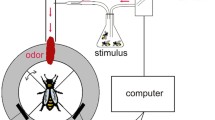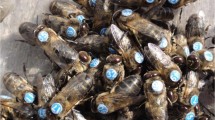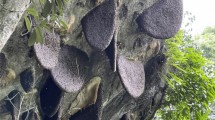Abstract
At a natural drone congregation area freeflying drones were attracted by a fast-moving queen dummy and the pursuits of drones were stereoscopically recorded (Fig. 1). The reconstruction of 192 flight paths from successfully approaching drones in chronological three dimensional sequences (Fig. 4) lead to the following results: 1. The alignment of the drone's longitudinal body axis coincides fairly well with the line connecting drone and queen (drone-queen-axis), its mean angular deviation from this line being only 14°. Angles between -5° and 5° occur most frequently (Fig. 5B). Thus, drones head straight to the queen. 2. Lateral deviations from the drone-queen-axis most frequently lie between — 30° and 30° (Fig. 5A) which corresponds to the drone's binocular visual field. 3. The drone's heading was continuously adjusted to the actual target, mean turning speed being 1890°/s. 4. The results lead to the conclusion that honeybee drones choose the shortest way to a fast and not predictably moving mate. A comparison with earlier observations suggests that a drone's mating success depends not only on his skills to win a race but also on his persistence within a group.
Similar content being viewed by others
References
Berg S (1992) Der Reproduktionserfolg von Drohnen (Apis mellifera L.) unterschiedlicher Größe. Dissertation Fachbereich Biologie J.W. Goethe Universität, Frankfurt a.M.
Brady J (1991) Flying mate detection and chasing by tsetse flies (Glossina). Physiol Entomol 16: 153–161
Brosius G, Brosius F (1995) SPSS — Base System und Professional Statistics. International Thomson Publishing Company, Bonn
Burkhardt D, Darnhofer-Demar B, Fischer K (1973) Zum binokularen Entfernungssehen der Insekten. I. Die Struktur des Sehraums von Synsekten. J Comp Physiol 87: 165–188
Esch H, Nachtigall W, Kogge SN (1975) Correlations between aerodynamic output, electrical activity in the indirect flight muscles and wing positions of bees flying in a servomechanically controlled wind tunnel. J Comp Physiol 100: 147–159
Free JB (1987) Pheromones of social bees. Chapman and Hall, Cambridge University Press
Gary NE (1962) Chemical attractants in the queen honey bee. Science 136: 773–774
Jacobson M (1972) Insect sex pheromones. Academic Press, New York, London
Koeniger G (1988) Mating flights of the honey bee drones (Apis mellifera L.). A film documentation. Biona Report 6: 29–34
Koeniger N, Koeniger G (1991) An evolutionary approach to mating behaviour and drone copulatory organs in Apis. Apidologie 22: 581–590
Koeniger G, Koeniger N, Fabritius M (1979) Some detailed observations of mating in the honeybee. Bee World 60: 53–57
Koeniger G, Koeniger N, Pechhacker H, Ruttner F, Berg S (1989) Assortative mating in a mixed population of European honeybees, Apis mellifera ligustica and Apis mellifera carnica. Insectes Sociaux 36: 129–138
Lehrer M (1994) Spatial vision in the honeybee: the use of different cues in different tasks. Vision Res 34: 2363–2385
Lehrer M, Srinivasan MV (1993) Object detection in honeybees: why do they land on edges? J Comp Physiol A 173: 23–32
Loper GM, Wolf OR, Taylor JR (1993) Radar detection of drones responding to honeybee queen pheromone. J Chem Ecol 19: 1929–1937
Menzel JG, Wunderer H, Stavenga DG (1991) Functional morphology of the compound eye of the honey bee. Tissue Cell 23: 525–535
Praagh JP van, Ribi W, Wehrhahn C, Wittmann D (1980) Drone bees fixate the queen with the dorso-frontal part of their compound eyes. J Comp Physiol 136: 263–266
Rayner JMV, Aldridge HDJN (1985) Three dimensional reconstruction of animal flightpaths and the turning flight of microchiropteran bats. J Exp Biol 118: 247–265
Ruttner F (1957) Die Sexualfunktionen der Honigbiene im Dienste ihrer sozialen Gemeinschaft. Z Vergl Physiol 39: 577–600
Ruttner F, Ruttner H (1966) Untersuchungen über die Flugaktivität und das Paarungsverhalten der Drohnen. 3. Flugweite und Flugrichtung der Drohnen. Z Bienenforsch 8: 332–354
Seidl R (1980) Die Sehfelder und Ommatidien-Divergenzwinkel der drei Kasten der Honigbiene (Apis mellifica). Verh Dtsch Zool Ges 1980: 367
Schwidevski K, Ackermann F (1976) Photogrammetrie: Grundlagen, Verfahren, Anwendungen. B.G. Teubner, Stuttgart
Thornhill R, Alcock J (1983) The evolution of insect mating systems. Harvard University Press, Cambridge, Massachusetts
Vallet AM, Coles JA (1993) The perception of small objects by the drone honeybee. J Comp Physiol A 172: 183–188
Woyke J (1960) Natural and artificial insemination of queen honey bees. Pszczeln Zesz Nauk 4: 183–275
Zmarlicki C, Morse RA (1963) Drone congregation areas. J Apic Res 2: 64–66
Author information
Authors and Affiliations
Rights and permissions
About this article
Cite this article
Gries, M., Koeniger, N. Straight forward to the queen: pursuing honeybee drones (Apis mellifera L.) adjust their body axis to the direction of the queen. J Comp Physiol A 179, 539–544 (1996). https://doi.org/10.1007/BF00192319
Accepted:
Issue Date:
DOI: https://doi.org/10.1007/BF00192319




